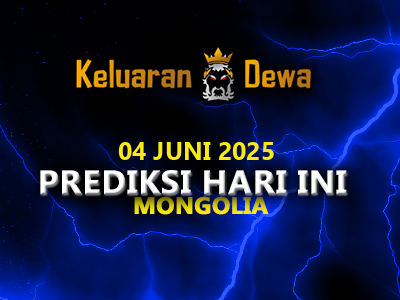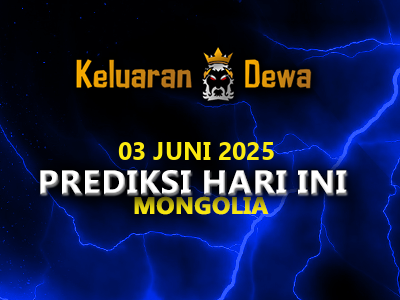Prediksi Keluaran Hongkong Kamis 5 Juni 2025 Terjitu Prediksi Keluaran Dewa Togel HK Hari Ini Kamis 05-06-2025 yang terjitu ini akan di bocorkan oleh team Keluaran Dewa. Ini adalah racikan angka keluar togel yang telah dirumuskan secara teliti oleh para ahlinya. Angka yang telah direkap oleh team kami memung […]
Prediksi Keluaran Taiwan Kamis 5 Juni 2025 Terjitu
Prediksi Keluaran Taiwan Kamis 5 Juni 2025 Terjitu Prediksi Keluaran Dewa Togel Taiwan Hari Ini Kamis 05-06-2025 yang terjitu ini akan di bocorkan oleh team Keluaran Dewa. Ini adalah racikan angka keluar togel yang telah dirumuskan secara teliti oleh para ahlinya. Angka yang telah direkap oleh team kami memu […]
Prediksi Keluaran Mongolia Kamis 5 Juni 2025 Terjitu
Prediksi Keluaran Mongolia Kamis 5 Juni 2025 Terjitu Prediksi Keluaran Dewa Togel Mongolia Hari Ini Kamis 05-06-2025 yang terjitu ini akan di bocorkan oleh team Keluaran Dewa. Ini adalah racikan angka keluar togel yang telah dirumuskan secara teliti oleh para ahlinya. Angka yang telah direkap oleh team kami […]
Prediksi Keluaran Singapore Kamis 5 Juni 2025 Terjitu
Prediksi Keluaran Singapore Kamis 5 Juni 2025 Terjitu Prediksi Keluaran Dewa Togel SGP Hari Ini Kamis 05-06-2025 yang terjitu ini akan di bocorkan oleh team Keluaran Dewa. Ini adalah racikan angka keluar togel yang telah dirumuskan secara teliti oleh para ahlinya. Angka yang telah direkap oleh team kami memu […]
Prediksi Keluaran Japan Kamis 5 Juni 2025 Terjitu
Prediksi Keluaran Japan Kamis 5 Juni 2025 Terjitu Prediksi Keluaran Dewa Togel Jepang Hari Ini Kamis 05-06-2025 yang terjitu ini akan di bocorkan oleh team Keluaran Dewa. Ini adalah racikan angka keluar togel yang telah dirumuskan secara teliti oleh para ahlinya. Angka yang telah direkap oleh team kami memun […]
Prediksi Keluaran China Kamis 5 Juni 2025 Terjitu
Prediksi Keluaran China Kamis 5 Juni 2025 Terjitu Prediksi Keluaran Dewa Togel China Hari Ini Kamis 05-06-2025 yang terjitu ini akan di bocorkan oleh team Keluaran Dewa. Ini adalah racikan angka keluar togel yang telah dirumuskan secara teliti oleh para ahlinya. Angka yang telah direkap oleh team kami memung […]
Prediksi Keluaran Sydney Kamis 5 Juni 2025 Terjitu
Prediksi Keluaran Sydney Kamis 5 Juni 2025 Terjitu Prediksi Keluaran Dewa Togel Sydney Hari ini Kamis 05-06-2025 yang terjitu ini akan dibocorkan oleh team Keluaran Dewa. Ini adalah racikan angka keluar togel yang telah dirumuskan secara teliti oleh para ahlinya. Angka yang telah direkap oleh team kami memun […]
Prediksi Keluaran Cambodia Kamis 5 Juni 2025 Terjitu
Prediksi Keluaran Cambodia Kamis 5 Juni 2025 Terjitu Prediksi Keluaran Dewa Togel Kamboja Hari Ini Kamis 05-06-2025 yang terjitu ini akan di bocorkan oleh team Keluaran Dewa. Ini adalah racikan angka keluar togel yang telah dirumuskan secara teliti oleh para ahlinya. Angka yang telah direkap oleh team kami m […]
Prediksi Keluaran Hongkong Rabu 4 Juni 2025 Terjitu
Prediksi Keluaran Hongkong Rabu 4 Juni 2025 Terjitu Prediksi Keluaran Dewa Togel HK Hari Ini Rabu 04-06-2025 yang terjitu ini akan di bocorkan oleh team Keluaran Dewa. Ini adalah racikan angka keluar togel yang telah dirumuskan secara teliti oleh para ahlinya. Angka yang telah direkap oleh team kami memungki […]
Prediksi Keluaran Taiwan Rabu 4 Juni 2025 Terjitu
Prediksi Keluaran Taiwan Rabu 4 Juni 2025 Terjitu Prediksi Keluaran Dewa Togel Taiwan Hari Ini Rabu 04-06-2025 yang terjitu ini akan di bocorkan oleh team Keluaran Dewa. Ini adalah racikan angka keluar togel yang telah dirumuskan secara teliti oleh para ahlinya. Angka yang telah direkap oleh team kami memung […]
Prediksi Keluaran Mongolia Rabu 4 Juni 2025 Terjitu
Prediksi Keluaran Mongolia Rabu 4 Juni 2025 Terjitu Prediksi Keluaran Dewa Togel Mongolia Hari Ini Rabu 04-06-2025 yang terjitu ini akan di bocorkan oleh team Keluaran Dewa. Ini adalah racikan angka keluar togel yang telah dirumuskan secara teliti oleh para ahlinya. Angka yang telah direkap oleh team kami me […]
Prediksi Keluaran Japan Rabu 4 Juni 2025 Terjitu
Prediksi Keluaran Japan Rabu 4 Juni 2025 Terjitu Prediksi Keluaran Dewa Togel Jepang Hari Ini Rabu 04-06-2025 yang terjitu ini akan di bocorkan oleh team Keluaran Dewa. Ini adalah racikan angka keluar togel yang telah dirumuskan secara teliti oleh para ahlinya. Angka yang telah direkap oleh team kami memungk […]
Prediksi Keluaran China Rabu 4 Juni 2025 Terjitu
Prediksi Keluaran China Rabu 4 Juni 2025 Terjitu Prediksi Keluaran Dewa Togel China Hari Ini Rabu 04-06-2025 yang terjitu ini akan di bocorkan oleh team Keluaran Dewa. Ini adalah racikan angka keluar togel yang telah dirumuskan secara teliti oleh para ahlinya. Angka yang telah direkap oleh team kami memungki […]
Prediksi Keluaran Sydney Rabu 4 Juni 2025 Terjitu
Prediksi Keluaran Sydney Rabu 4 Juni 2025 Terjitu Prediksi Keluaran Dewa Togel Sydney Hari ini Rabu 04-06-2025 yang terjitu ini akan dibocorkan oleh team Keluaran Dewa. Ini adalah racikan angka keluar togel yang telah dirumuskan secara teliti oleh para ahlinya. Angka yang telah direkap oleh team kami memungk […]
Prediksi Keluaran Cambodia Rabu 4 Juni 2025 Terjitu
Prediksi Keluaran Cambodia Rabu 4 Juni 2025 Terjitu Prediksi Keluaran Dewa Togel Kamboja Hari Ini Rabu 04-06-2025 yang terjitu ini akan di bocorkan oleh team Keluaran Dewa. Ini adalah racikan angka keluar togel yang telah dirumuskan secara teliti oleh para ahlinya. Angka yang telah direkap oleh team kami mem […]
Prediksi Keluaran Cambodia Rabu 4 Juni 2025 Terjitu
Prediksi Keluaran Cambodia Rabu 4 Juni 2025 Terjitu Prediksi Keluaran Dewa Togel Kamboja Hari Ini Rabu 04-06-2025 yang terjitu ini akan di bocorkan oleh team Keluaran Dewa. Ini adalah racikan angka keluar togel yang telah dirumuskan secara teliti oleh para ahlinya. Angka yang telah direkap oleh team kami mem […]
Prediksi Keluaran Hongkong Selasa 3 Juni 2025 Terjitu
Prediksi Keluaran Hongkong Selasa 3 Juni 2025 Terjitu Prediksi Keluaran Dewa Togel HK Hari Ini Selasa 03-06-2025 yang terjitu ini akan di bocorkan oleh team Keluaran Dewa. Ini adalah racikan angka keluar togel yang telah dirumuskan secara teliti oleh para ahlinya. Angka yang telah direkap oleh team kami memu […]
Prediksi Keluaran Taiwan Selasa 3 Juni 2025 Terjitu
Prediksi Keluaran Taiwan Selasa 3 Juni 2025 Terjitu Prediksi Keluaran Dewa Togel Taiwan Hari Ini Selasa 03-06-2025 yang terjitu ini akan di bocorkan oleh team Keluaran Dewa. Ini adalah racikan angka keluar togel yang telah dirumuskan secara teliti oleh para ahlinya. Angka yang telah direkap oleh team kami me […]
Prediksi Keluaran Mongolia Selasa 3 Juni 2025 Terjitu
Prediksi Keluaran Mongolia Selasa 3 Juni 2025 Terjitu Prediksi Keluaran Dewa Togel Mongolia Hari Ini Selasa 03-06-2025 yang terjitu ini akan di bocorkan oleh team Keluaran Dewa. Ini adalah racikan angka keluar togel yang telah dirumuskan secara teliti oleh para ahlinya. Angka yang telah direkap oleh team kam […]
Prediksi Keluaran Singapore Rabu 4 Juni 2025 Terjitu
Prediksi Keluaran Singapore Rabu 4 Juni 2025 Terjitu Prediksi Keluaran Dewa Togel SGP Hari Ini Rabu 04-06-2025 yang terjitu ini akan di bocorkan oleh team Keluaran Dewa. Ini adalah racikan angka keluar togel yang telah dirumuskan secara teliti oleh para ahlinya. Angka yang telah direkap oleh team kami memung […]



















